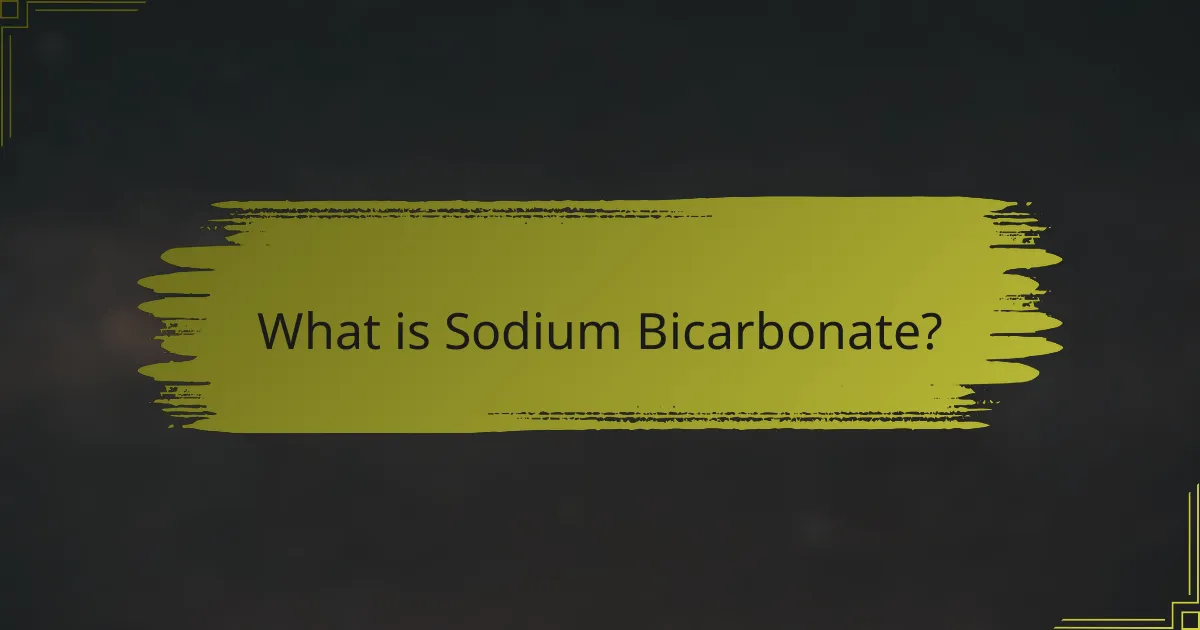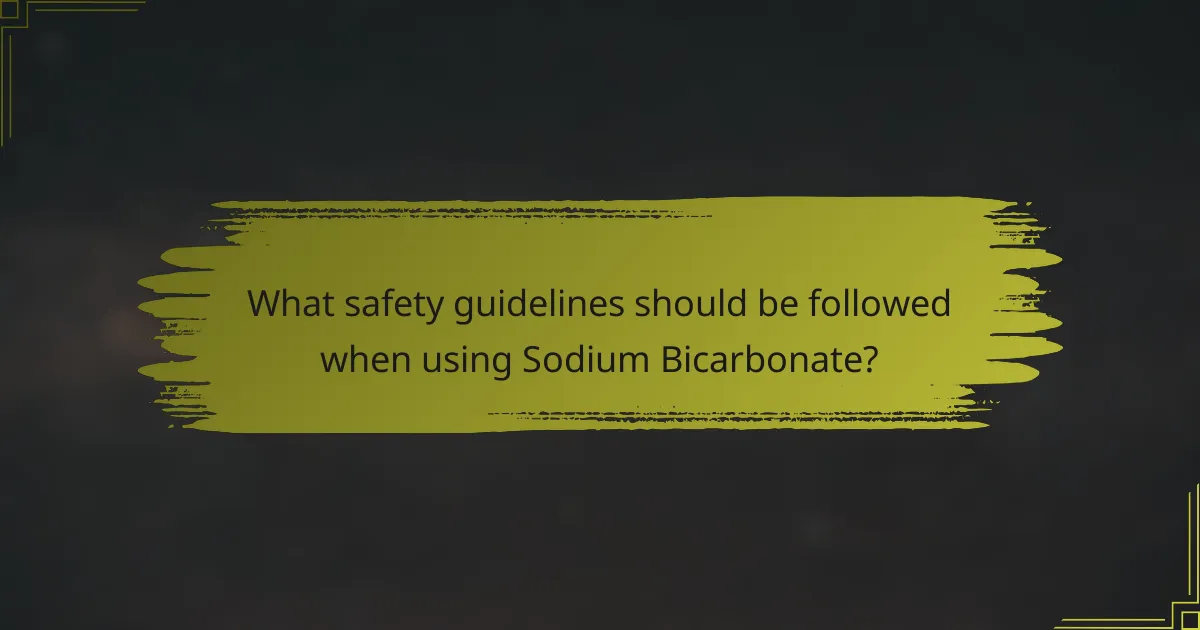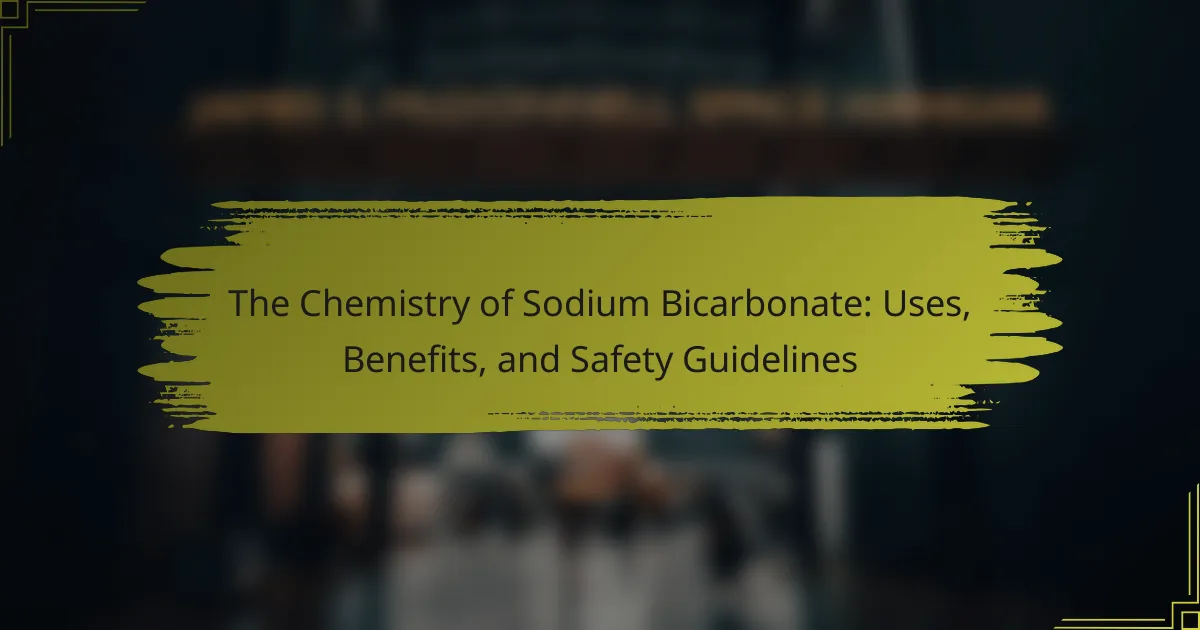
What is Sodium Bicarbonate?
Sodium bicarbonate is a chemical compound with the formula NaHCO3. It is commonly known as baking soda. Sodium bicarbonate is a white crystalline solid that appears as a fine powder. It is alkaline in nature and has a slightly salty taste. This compound is often used in cooking, particularly in baking, as a leavening agent. Additionally, sodium bicarbonate is utilized in various industries, including pharmaceuticals and personal care. It also serves as an antacid to relieve heartburn and indigestion. The compound reacts with acids to produce carbon dioxide, which helps baked goods rise.
How is Sodium Bicarbonate chemically composed?
Sodium bicarbonate is chemically composed of sodium (Na), hydrogen (H), carbon (C), and oxygen (O). Its chemical formula is NaHCO3. This indicates it contains one sodium atom, one hydrogen atom, one carbon atom, and three oxygen atoms. Sodium bicarbonate is an ionic compound. It consists of sodium ions and bicarbonate ions. The bicarbonate ion is made up of one hydrogen atom, one carbon atom, and three oxygen atoms. Sodium bicarbonate is commonly known as baking soda. Its properties make it useful in various applications, including cooking and cleaning.
What are the key chemical properties of Sodium Bicarbonate?
Sodium Bicarbonate, also known as baking soda, has several key chemical properties. It is a white crystalline solid with a chemical formula of NaHCO₃. Sodium Bicarbonate is a weak alkaline compound. It reacts with acids to produce carbon dioxide gas, water, and a salt. The reaction occurs due to its ability to donate bicarbonate ions. It has a solubility of approximately 9.6 g per 100 mL of water at room temperature. Sodium Bicarbonate decomposes upon heating to produce sodium carbonate, water, and carbon dioxide. Its pH in solution is typically around 8.4. These properties make it useful in various applications, including baking and as a buffering agent.
How does Sodium Bicarbonate react with acids and bases?
Sodium bicarbonate reacts with acids to produce carbon dioxide gas, water, and a salt. When sodium bicarbonate encounters an acid, such as hydrochloric acid, a chemical reaction occurs. This reaction releases carbon dioxide, which is visible as bubbles. The equation for this reaction is NaHCO3 + HCl → CO2 + H2O + NaCl.
In contrast, sodium bicarbonate reacts with strong bases to form a salt and water without producing carbon dioxide. For example, when sodium bicarbonate interacts with sodium hydroxide, the result is a neutralization reaction. The equation for this reaction is NaHCO3 + NaOH → Na2CO3 + H2O.
These reactions demonstrate sodium bicarbonate’s role as a mild acid and base neutralizer. Its ability to react with both acids and bases makes it valuable in various applications, including cooking and medicinal uses.
What are the common uses of Sodium Bicarbonate?
Sodium bicarbonate is commonly used as a baking ingredient, antacid, and cleaning agent. In baking, it acts as a leavening agent, helping dough rise. It reacts with acids to produce carbon dioxide, which creates air pockets in baked goods. As an antacid, sodium bicarbonate neutralizes stomach acid, providing relief from heartburn and indigestion. It is also used in personal care products, such as toothpaste, for its mild abrasive properties. Additionally, sodium bicarbonate serves as a household cleaner, effectively removing stains and odors. In swimming pools, it helps maintain pH balance, promoting water clarity and comfort. Lastly, it has applications in fire extinguishers, where it acts as a flame retardant.
How is Sodium Bicarbonate utilized in cooking and baking?
Sodium bicarbonate is utilized in cooking and baking primarily as a leavening agent. It reacts with acidic components in the batter or dough, producing carbon dioxide gas. This gas causes the mixture to rise, resulting in a light and fluffy texture. Common acidic ingredients that activate sodium bicarbonate include vinegar, lemon juice, and yogurt.
In baking, it is often used in recipes for cakes, cookies, and breads. The reaction occurs quickly, so it is important to bake the mixture soon after combining. This ensures maximum leavening effect.
Sodium bicarbonate can also enhance browning in baked goods through the Maillard reaction. This reaction contributes to flavor and color development. Its effectiveness is seen in recipes that require a quick rise.
Overall, sodium bicarbonate is a versatile ingredient that plays a crucial role in the baking process.
What role does Sodium Bicarbonate play in cleaning products?
Sodium Bicarbonate acts as a cleaning agent in various products. It effectively neutralizes odors, making it useful in deodorizing applications. This compound also helps to remove stains and grime due to its mild abrasive properties. Sodium Bicarbonate can dissolve grease and dirt when mixed with water. Additionally, it reacts with acids, enhancing its cleaning power. Its non-toxic nature makes it safe for household use. Studies have shown its effectiveness in cleaning surfaces and fabrics. This versatility contributes to its widespread use in cleaning formulations.

What are the benefits of Sodium Bicarbonate?
Sodium Bicarbonate offers several benefits. It acts as an antacid, neutralizing stomach acid and providing relief from heartburn. Sodium Bicarbonate is also used to treat metabolic acidosis, helping to balance pH levels in the body. Additionally, it enhances athletic performance by reducing lactic acid buildup during exercise. Research shows that it can improve endurance in high-intensity activities. Furthermore, Sodium Bicarbonate is effective in treating kidney stones by alkalizing urine. Its antibacterial properties make it useful in oral hygiene products. Overall, Sodium Bicarbonate serves multiple health-related purposes.
How does Sodium Bicarbonate contribute to health and wellness?
Sodium bicarbonate contributes to health and wellness by acting as an antacid and alkalizing agent. It neutralizes stomach acid, providing relief from heartburn and indigestion. This compound can also enhance athletic performance by buffering lactic acid during intense exercise. Studies indicate that sodium bicarbonate supplementation may improve endurance and reduce fatigue. Additionally, it plays a role in maintaining proper pH levels in the body. This balancing effect supports overall metabolic functions. Research has shown that sodium bicarbonate can aid in kidney function by reducing acidity in urine. Its use in certain medical treatments demonstrates its versatility in promoting health.
What are the potential health benefits of Sodium Bicarbonate?
Sodium bicarbonate, commonly known as baking soda, has several potential health benefits. It may help alleviate symptoms of heartburn by neutralizing stomach acid. Research indicates that it can improve exercise performance by reducing lactic acid buildup in muscles. Sodium bicarbonate may also assist in maintaining pH balance in the body, which is crucial for overall health. Additionally, it has been used in some medical treatments, such as managing metabolic acidosis. Clinical studies suggest that it can enhance kidney function by reducing the acidity of urine. Furthermore, it may play a role in oral health by acting as a mild abrasive for teeth cleaning.
How can Sodium Bicarbonate improve digestive health?
Sodium bicarbonate can improve digestive health by neutralizing stomach acid. This can alleviate symptoms of indigestion and heartburn. When taken, it reacts with hydrochloric acid in the stomach, forming carbon dioxide and water. This reaction reduces acidity, providing relief from discomfort. A study published in the Journal of Clinical Gastroenterology found that sodium bicarbonate effectively reduced symptoms in patients with gastroesophageal reflux disease (GERD). Additionally, it may promote a more alkaline environment in the digestive tract, which can benefit gut health.
What environmental benefits does Sodium Bicarbonate offer?
Sodium bicarbonate offers several environmental benefits. It acts as a natural pH buffer, helping to neutralize acidic soils and water bodies. This property can enhance soil health and promote plant growth. Sodium bicarbonate is biodegradable and non-toxic, making it a safer alternative to harsh chemicals. It can also reduce the need for synthetic fertilizers and pesticides, minimizing chemical runoff into ecosystems. Additionally, its use in cleaning products reduces environmental pollution. Studies show that using sodium bicarbonate in agriculture can lead to improved crop yields while maintaining ecological balance.
How does Sodium Bicarbonate serve as a safer alternative in various applications?
Sodium Bicarbonate serves as a safer alternative in various applications due to its non-toxic and environmentally friendly properties. It is commonly used in baking as a leavening agent, replacing harsher chemicals like ammonium bicarbonate. In cleaning, Sodium Bicarbonate effectively removes stains and odors without harmful residues. It is also used in personal care products, acting as a gentle exfoliant and pH balancer. In agriculture, it serves as a natural fungicide, reducing reliance on synthetic pesticides. Studies show that Sodium Bicarbonate is less irritating to skin and eyes compared to many commercial cleaners. Its safety profile is supported by the FDA, which recognizes it as Generally Recognized As Safe (GRAS). These attributes make Sodium Bicarbonate a versatile and safer option across multiple sectors.
What is the impact of Sodium Bicarbonate on reducing chemical use?
Sodium Bicarbonate significantly impacts reducing chemical use by serving as a safer alternative to various harsh chemicals. It can replace toxic cleaning agents in households and industries. For example, it effectively removes stains and odors without harmful residues. In agriculture, it acts as a natural fungicide, reducing the need for synthetic pesticides. Studies show that using Sodium Bicarbonate can lower chemical exposure risks for humans and the environment. Its versatility as a buffering agent also minimizes the need for additional chemical additives in food processing. Overall, Sodium Bicarbonate contributes to more sustainable practices across multiple sectors.

What safety guidelines should be followed when using Sodium Bicarbonate?
When using sodium bicarbonate, follow these safety guidelines: Always store sodium bicarbonate in a cool, dry place. Keep it out of reach of children and pets. Avoid inhaling the powder, as it can irritate the respiratory system. Wear gloves and eye protection when handling large quantities. Do not mix sodium bicarbonate with strong acids, as this can produce harmful gases. If ingested in large amounts, seek medical attention. According to the National Institutes of Health, sodium bicarbonate is generally recognized as safe when used properly.
What precautions should be taken when handling Sodium Bicarbonate?
Wear appropriate personal protective equipment, such as gloves and goggles, when handling sodium bicarbonate. This chemical can cause irritation to the skin and eyes. Use it in a well-ventilated area to avoid inhaling dust. Keep it away from strong acids, as it can react and produce carbon dioxide gas. Store sodium bicarbonate in a cool, dry place, away from moisture. Ensure containers are tightly sealed to prevent contamination. Dispose of any waste material according to local regulations. Following these precautions ensures safe handling and minimizes risks associated with sodium bicarbonate.
How should Sodium Bicarbonate be stored to ensure safety?
Sodium Bicarbonate should be stored in a cool, dry place. It is important to keep it in an airtight container. Exposure to moisture can cause clumping and reduce effectiveness. Additionally, it should be kept away from strong acids and bases. This prevents potential chemical reactions. The storage area should be well-ventilated to avoid the buildup of any gases. Labeling the container clearly helps in identifying the substance. Following these guidelines ensures the safety and stability of Sodium Bicarbonate.
What are the potential side effects of Sodium Bicarbonate?
Potential side effects of Sodium Bicarbonate include gastrointestinal issues, such as gas and bloating. It can also cause metabolic alkalosis, which occurs when the body’s pH becomes too alkaline. High doses may lead to increased sodium levels, resulting in hypertension or fluid retention. Some individuals may experience muscle spasms or twitching due to electrolyte imbalances. Additionally, allergic reactions, though rare, can occur. These side effects have been documented in various clinical studies, emphasizing the importance of monitoring dosage and individual response.
How can Sodium Bicarbonate be used safely in various applications?
Sodium bicarbonate can be used safely in various applications by following specific guidelines. In cooking, it acts as a leavening agent when combined with acidic ingredients. For cleaning, it serves as a mild abrasive and deodorizer. In personal care, it can be used in toothpaste to help whiten teeth. For health, it can alleviate heartburn when taken in recommended doses.
Safety measures include using food-grade sodium bicarbonate for culinary purposes. For cleaning, avoid mixing it with vinegar in confined spaces to prevent excessive foaming. When used for health, consult with a healthcare provider for appropriate dosages.
Research shows that sodium bicarbonate is generally recognized as safe by the FDA when used appropriately. Its versatility makes it effective across multiple domains while adhering to safety protocols ensures its safe use.
What best practices should be followed when using Sodium Bicarbonate in cooking?
Use Sodium Bicarbonate in cooking as a leavening agent or to tenderize food. It reacts with acidic ingredients to produce carbon dioxide, which helps baked goods rise. Measure accurately; too much can lead to a soapy taste. Mix it with dry ingredients before adding wet ones for even distribution. Store it in a cool, dry place to maintain potency. Avoid using it in recipes that don’t contain an acid, as it won’t activate. Rinse foods treated with it, like vegetables, to remove excess residue. These practices ensure effective and safe use in various culinary applications.
What guidelines should be observed when using Sodium Bicarbonate for cleaning?
When using Sodium Bicarbonate for cleaning, several guidelines should be observed. First, always test on a small, inconspicuous area before applying it to larger surfaces. This ensures no damage occurs. Second, mix Sodium Bicarbonate with water to create a paste for tougher stains. This method is effective for removing grime. Third, avoid using it on aluminum surfaces, as it can cause discoloration. Fourth, ensure proper ventilation when using it, especially in enclosed spaces. This minimizes inhalation risks. Lastly, store Sodium Bicarbonate in a cool, dry place to maintain its effectiveness. Following these guidelines helps ensure safe and effective cleaning.
What troubleshooting tips are important for using Sodium Bicarbonate effectively?
Ensure the sodium bicarbonate is fresh and stored properly. Old or improperly stored sodium bicarbonate can lose effectiveness. Use it within six months for best results. Mix it with water to activate it for cleaning or cooking. Ensure the water is at least room temperature for optimal dissolution. Avoid using metal containers, as they can react with sodium bicarbonate. Always measure the correct amount based on the intended use. For baking, follow the recipe precisely to avoid imbalances. If it fizzes excessively when mixed with acid, check the freshness and concentration.
Sodium bicarbonate, commonly known as baking soda, is a versatile chemical compound with the formula NaHCO3. This article delves into its chemical composition, key properties, and various applications, including its roles in cooking, cleaning, and health. It also highlights the benefits of sodium bicarbonate, such as its use as an antacid and its potential to enhance athletic performance. Additionally, safety guidelines for handling and storing sodium bicarbonate are outlined, along with troubleshooting tips for effective use in different contexts.
